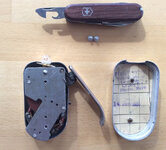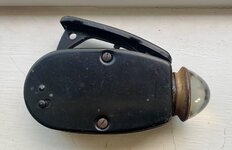Dr. Jones
Newly Enlightened
For many years after the fall of the Soviet Union, such items as dry-cell batteries were in short supply or economically unobtainable for the average citizen, and many of these manual flashlights were produced. The particular model referenced here appears to have been made for export, and was purchased commercially here in the U.S. in the late 1990s.
The flashlight's maker is unknown to me (their logo appears to be in Cyrillic). It has a lock for the charging handle and adjusts from wide to narrow focus. The bulb appears to be a standard E10 screw base type, and is rated at 2.5 volts and 0.5 amperes according to the stamping on its base.
There is a small white plastic lock for the charging handle to keep it in place when not in use, seen at the rear underside of the flashlight in the attached images below. The focus mechanism uses a white plastic button, located on the front top, to move the entire bulb assembly, with forward being wide focus and back being tight. The bulb moves through a hole in the center of the reflector, which remains stationary. The reflector is chromed plastic, protected by a flat rectangular glass lens approximately 1/8" thick, with a black snap-on plastic collar to hold both lens and reflector in place.
The mechanism appears to be quite sturdy, and consists of a heavy cast metal charging handle with an attached plastic gear sector, which when repeatedly squeezed engages a set of plastic gears (whose longevity is likely fairly uncertain) which in turn rapidly spin a metal rotor with embedded magnets; these magnets rotate under a pair of copper coils, which produces current for the filament.
Performance is what one would expect from such an arrangement, and provides enough light to navigate, providing one's hand doesn't give out! In use, it really doesn't take much effort to generate sufficient current to fully light the bulb, and the slow, repetitive squeeze required is fairly easy to maintain for long periods. Such relatively gentle treatment will no doubt help to preserve the plastic gears. The rotor acts as a flywheel, and although the light pulses a bit, it is perfectly serviceable.
I wanted to see if using a #222 pre-focused bulb would be an improvement on the original, so ran some brief tests. The results can be seen in the attached photos (the first two light tests, wide and narrow, are the #222); I'd give the nod to the pre-focused bulb, as it seems to be the better performer overall.
All in all, a very well-made and unusual item. Its clones and contemporaries in its country of origin during a period of considerable privation were no doubt godsends to those who otherwise would not have had a working flashlight available to them.
The flashlight's maker is unknown to me (their logo appears to be in Cyrillic). It has a lock for the charging handle and adjusts from wide to narrow focus. The bulb appears to be a standard E10 screw base type, and is rated at 2.5 volts and 0.5 amperes according to the stamping on its base.
There is a small white plastic lock for the charging handle to keep it in place when not in use, seen at the rear underside of the flashlight in the attached images below. The focus mechanism uses a white plastic button, located on the front top, to move the entire bulb assembly, with forward being wide focus and back being tight. The bulb moves through a hole in the center of the reflector, which remains stationary. The reflector is chromed plastic, protected by a flat rectangular glass lens approximately 1/8" thick, with a black snap-on plastic collar to hold both lens and reflector in place.
The mechanism appears to be quite sturdy, and consists of a heavy cast metal charging handle with an attached plastic gear sector, which when repeatedly squeezed engages a set of plastic gears (whose longevity is likely fairly uncertain) which in turn rapidly spin a metal rotor with embedded magnets; these magnets rotate under a pair of copper coils, which produces current for the filament.
Performance is what one would expect from such an arrangement, and provides enough light to navigate, providing one's hand doesn't give out! In use, it really doesn't take much effort to generate sufficient current to fully light the bulb, and the slow, repetitive squeeze required is fairly easy to maintain for long periods. Such relatively gentle treatment will no doubt help to preserve the plastic gears. The rotor acts as a flywheel, and although the light pulses a bit, it is perfectly serviceable.
I wanted to see if using a #222 pre-focused bulb would be an improvement on the original, so ran some brief tests. The results can be seen in the attached photos (the first two light tests, wide and narrow, are the #222); I'd give the nod to the pre-focused bulb, as it seems to be the better performer overall.
All in all, a very well-made and unusual item. Its clones and contemporaries in its country of origin during a period of considerable privation were no doubt godsends to those who otherwise would not have had a working flashlight available to them.
Attachments
-
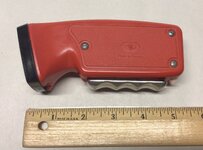 72AFAD11-B3EB-4534-B60F-D4F361F19E99.jpeg394 KB · Views: 93
72AFAD11-B3EB-4534-B60F-D4F361F19E99.jpeg394 KB · Views: 93 -
 91D143DC-121C-48D3-AE44-42860A81E144.jpeg278.5 KB · Views: 101
91D143DC-121C-48D3-AE44-42860A81E144.jpeg278.5 KB · Views: 101 -
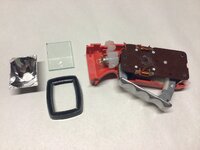 BFD5EDBF-E26B-49A1-9310-CCC176CC79B0.jpeg341.8 KB · Views: 97
BFD5EDBF-E26B-49A1-9310-CCC176CC79B0.jpeg341.8 KB · Views: 97 -
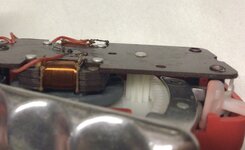 9FF7F8D1-359F-438F-BFC9-B3E6E119B094.jpeg252 KB · Views: 91
9FF7F8D1-359F-438F-BFC9-B3E6E119B094.jpeg252 KB · Views: 91 -
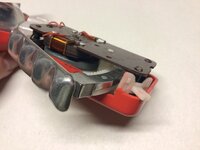 3E17F766-8298-40B2-8932-A3E8B6B9C88D.jpeg314.4 KB · Views: 98
3E17F766-8298-40B2-8932-A3E8B6B9C88D.jpeg314.4 KB · Views: 98 -
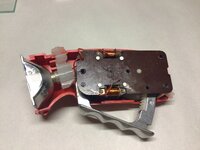 7F9CE158-4732-484B-BD63-D53BF6DBFED4.jpeg359.5 KB · Views: 94
7F9CE158-4732-484B-BD63-D53BF6DBFED4.jpeg359.5 KB · Views: 94 -
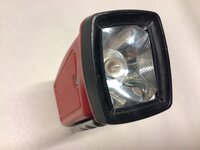 6DF663A4-5ED6-43A4-9C59-A97ED01114DF.jpeg317.5 KB · Views: 91
6DF663A4-5ED6-43A4-9C59-A97ED01114DF.jpeg317.5 KB · Views: 91 -
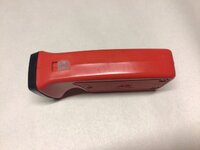 395CB038-69B3-41C2-A7C2-0D2283CD5E1E.jpeg309.3 KB · Views: 95
395CB038-69B3-41C2-A7C2-0D2283CD5E1E.jpeg309.3 KB · Views: 95 -
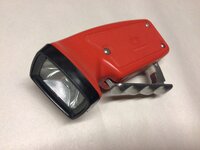 DEC01E5E-5BE7-4C2D-9E73-E7EA0DA37A9D.jpeg337.3 KB · Views: 96
DEC01E5E-5BE7-4C2D-9E73-E7EA0DA37A9D.jpeg337.3 KB · Views: 96 -
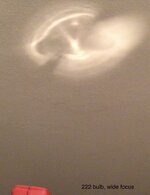 50C24D84-9129-48EB-9972-D600061D4CEE.jpeg579.6 KB · Views: 79
50C24D84-9129-48EB-9972-D600061D4CEE.jpeg579.6 KB · Views: 79 -
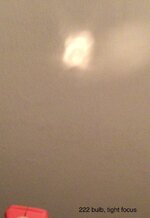 97CAA510-E3C5-437F-BD99-CE8B93386BAC.jpeg284.6 KB · Views: 88
97CAA510-E3C5-437F-BD99-CE8B93386BAC.jpeg284.6 KB · Views: 88 -
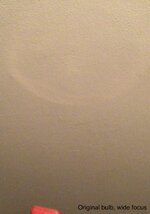 E4C092FD-DDE1-4B6B-A6C9-8EBBCF3B06EF.jpeg362.6 KB · Views: 83
E4C092FD-DDE1-4B6B-A6C9-8EBBCF3B06EF.jpeg362.6 KB · Views: 83 -
 457141D4-AFEF-4E55-BF99-11039232848E.jpeg354.7 KB · Views: 87
457141D4-AFEF-4E55-BF99-11039232848E.jpeg354.7 KB · Views: 87
Last edited:


